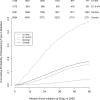Determining the optimal screening interval for type 2 diabetes mellitus using a risk prediction model
- PMID: 29135987
- PMCID: PMC5685604
- DOI: 10.1371/journal.pone.0187695
Determining the optimal screening interval for type 2 diabetes mellitus using a risk prediction model
Abstract
Background: Progression to diabetes mellitus (DM) is variable and the screening time interval not well defined. The American Diabetes Association and US Preventive Services Task Force suggest screening every 3 years, but evidence is limited. The objective of the study was to develop a model to predict the probability of developing DM and suggest a risk-based screening interval.
Methods: We included non-diabetic adult patients screened for DM in the Cleveland Clinic Health System if they had at least two measurements of glycated hemoglobin (HbA1c), an initial one less than 6.5% (48 mmol/mol) in 2008, and another between January, 2009 and December, 2013. Cox proportional hazards models were created. The primary outcome was DM defined as HbA1C greater than 6.4% (46 mmol/mol). The optimal rescreening interval was chosen based on the predicted probability of developing DM.
Results: Of 5084 participants, 100 (4.4%) of the 2281 patients with normal HbA1c and 772 (27.5%) of the 2803 patients with prediabetes developed DM within 5 years. Factors associated with developing DM included HbA1c (HR per 0.1 units increase 1.20; 95%CI, 1.13-1.27), family history (HR 1.31; 95%CI, 1.13-1.51), smoking (HR 1.18; 95%CI, 1.03-1.35), triglycerides (HR 1.01; 95%CI, 1.00-1.03), alanine aminotransferase (HR 1.07; 95%CI, 1.03-1.11), body mass index (HR 1.06; 95%CI, 1.01-1.11), age (HR 0.95; 95%CI, 0.91-0.99) and high-density lipoproteins (HR 0.93; 95% CI, 0.90-0.95). Five percent of patients in the highest risk tertile developed DM within 8 months, while it took 35 months for 5% of the middle tertile to develop DM. Only 2.4% percent of the patients in the lowest tertile developed DM within 5 years.
Conclusion: A risk prediction model employing commonly available data can be used to guide screening intervals. Based on equal intervals for equal risk, patients in the highest risk category could be rescreened after 8 months, while those in the intermediate and lowest risk categories could be rescreened after 3 and 5 years respectively.
Conflict of interest statement
Figures



References
-
- American Diabetes A. Diagnosis and classification of diabetes mellitus. Diabetes care. 2014;37 Suppl 1:S81–90. doi: 10.2337/dc14-S081 . - DOI - PubMed
-
- CDC. http://www.cdc.gov/diabetes/pubs/statsreport14/national-diabetes-report-.... Access date 01/01/2016 [01/01/2016]. Available from: http://www.cdc.gov/diabetes/pubs/statsreport14/national-diabetes-report-....
-
- Nathan DM, Davidson MB, DeFronzo RA, Heine RJ, Henry RR, Pratley R, et al. Impaired fasting glucose and impaired glucose tolerance: implications for care. Diabetes care. 2007;30(3):753–9. doi: 10.2337/dc07-9920 . - DOI - PubMed
-
- Khavandi K, Amer H, Ibrahim B, Brownrigg J. Strategies for preventing type 2 diabetes: an update for clinicians. Therapeutic advances in chronic disease. 2013;4(5):242–61. doi: 10.1177/2040622313494986 ; PubMed Central PMCID: PMC3752182. - DOI - PMC - PubMed
-
- Siu AL, Force USPST. Screening for Abnormal Blood Glucose and Type 2 Diabetes Mellitus: U.S. Preventive Services Task Force Recommendation Statement. Annals of internal medicine. 2015;163(11):861–8. doi: 10.7326/M15-2345 . - DOI - PubMed
MeSH terms
Substances
LinkOut - more resources
Full Text Sources
Other Literature Sources
Medical

